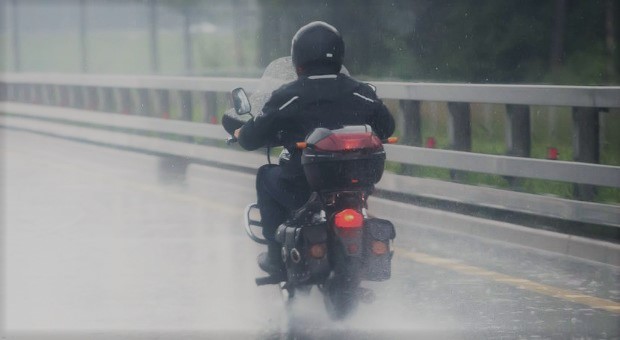You’re out on a ride on a lonely backroad, thirty miles from home, and it starts pouring rain. Ideally, the best option would be to pull over and wait it out.
Realistically, you may have to pick up the kids, be riding to work, or be bugging out. At that point, pulling over is not an option.
Rain changes the game, but with the proper skills you can make the ride much safer when the roads are slippery and you can hardly see. Here’s what to do!
Wear a Full-Face Helmet
Wearing a full-face helmet, at least during inclement weather, is the first step toward making your ride safer. Broken legs heal. Broken skulls or brains usually do not.
As an additional bonus, a helmet serves to keep your head dry and warm and keeps the rain from beating in your face and eyes, thus preventing distraction and improving vision.
If you’ve never ridden in the rain, even a light drizzle feels like you’re getting hit with gravel when you’re going 40 or 50 mph. It’s hard to focus on the road and other drivers when it feels like you’re getting exfoliated with a sandblaster.
Adding a layer of Rain-x to your face shield will help repel the rain so that your visibility is improved even more.
Have Good Boots
There are all kinds of fancy boots out there that look great but remember that their primary purpose is protection.
For riding in bad weather, it’s good to have tall boots that cover your shins. This helps keep you warm and dry (if they’re waterproofed) as well as protect you from losing your footing when you put your feet down.
Especially in inclement weather, it’s important to have boots that have non-skid bottoms. You can find non-skids in every design – cruising and racing. The most important factors are comfort and grip, so try several pairs on to see which ones fit the best. Scoot a little to see if they truly are “grippy.”
Wear a Sturdy Coat Designed for Riding
I’ve been down twice – once while wearing a T-shirt and once while wearing full race gear, which included high-quality racing leathers. Fortunately, I was going slow – about 20 mph when I went down wearing the T-shirt, but I still have the scar on my arm from the road rash, and it was difficult and painful to clean out the dirt and gravel, and care for it while it healed.
When I was wearing the leather, I was on the track and went down at 65 mph. I had no skin injuries whatsoever, and I slid for over 20 feet. The leather made all the difference. I also have both a leather motorcycle jacket and a nylon/Kevlar jacket that’s more in line with the sportbike that I ride. The leather is waterproof and offers supreme protection in cold, rainy weather.
I specifically recommend jackets/coats designed for motorcycles because they have three features developed just for riding
- the tail is longer in the back so that it doesn’t ride up,
- there are zippers on the sleeves that zip so that they’re snug around your wrists to keep out cold air and rain/snow,
- the zippers have pull tags on them so that you can zip/unzip with gloves on.
Also, the pockets zip up instead of down to prevent the zipper from opening while you’re riding.
Keep in mind that safety is number one priority when riding a bike and you have to be prepared for anything and to assume full responsibility for your personal safety.
Carry Survival Tools
I never leave the house without my backpack (saddle bags are nice, but don’t really come with sport bikes). I carry various survival/emergency items that include:
- The common sockets/wrenches that fit my bike
- Zip ties
- Faro stick/striker
- Fire starter – Vaseline-soaked cotton balls in a baggie
- A Bracelet made of 550 paracord
- A bottle of water
- OTC pain killer
- A knife
- A baggie to put my phone and gadgets in so they stay dry
- A couple of granola bars
- A hand mirror
- A whistle
- A sweatshirt/extra T-shirt – wet shirts are miserable when you reach your destination, and it tends to get chilly once the sun goes down.
- A small flashlight
Yes, that may sound like overkill and some of my rider friends tease me about it, but only until their bike breaks down or it starts raining and they want to put their phone in my baggie. Then I’m not so silly.
Get your FREE easy to use and safely concealable Smith and Wesson Tactical Folding knife!
Wear Gloves
Wearing gloves serves two purposes – they protect your hands and keep the oils in your hands from degrading the rubber in your grips.
Choose gloves that are reinforced on the top of the knuckles and palms in case you go down. Those are the two areas that are most likely to come into contact with the pavement.
Wear Chaps
You’d be surprised how much a pair of chaps protects your legs from the cold and rain/snow. Of course, they also provide an extra layer of protection in case you go down.
Avoid Road Paint and Other Road Debris
Now that we’ve covered gear, let’s talk about some road hazards. Road paint – you know, those white lines used at stop lights/signs or to designate parking spots – is like stepping on ice when it’s wet. Even in non-skid boots, it’s slick. Avoid it.
The same thing goes for sand, leaves, oil, and other materials that gather on the road. Watch where you put your feet.
Also, when it first starts raining, the oils, grease, and other slick material on the road is washed to the surface and distributed all over the road, so the pavement is going to be extra slick.
Look Ahead
In good weather, leave yourself plenty of room to see what’s on the road at least 30 feet in front of you. Double or even triple that if the roads are wet or icy.
Remember, you’re on two wheels, so you don’t have the ability to lock up the brakes, and if you run over something such as large stones, animal carcasses, puddles, or small limbs, it’s hard to stay in control.
Also, it tends to hurt when you rear-end them and you need more road to stop than you would in a car. Pay attention.
Ride Staggered
I know that riding what’s called 2-up (side-by-side) seems nice, but it’s not safe for a wide variety of reasons, especially in bad weather.
You (and other riders) need room to dodge road debris, standing water or ice, loose sand or gravel, and cars that may not see you and come into your lane. You also need room in case you take turns a bit too wide or have a tire blow-out.
For all of the same reasons, you need to ride on the opposite side of the lane as the rider in front of you, with your front wheel no closer than several feet behind and to the side of him/her. In addition to being safer in case something happens, this also keeps you from getting a face full of road water coming off the spray of the rear tire in front of you.
Keep Bike in Good Repair
This is the safety tip that you can’t afford to ignore. If your bike breaks down in inclement weather on a back road, you may just find yourself stuck for hours or even overnight., a flat is tough to recover from when road conditions are perfect, but if they’re wet or icy, the chances of an accident increase exponentially.
Slow Down
It’s tempting to want to hurry to get somewhere warm and dry, but when you combine decreased visibility with poor road conditions, you’re asking for trouble. You’re likely already soaked to the bone, so another few minutes or so isn’t going to make much of a difference.
Riding a motorcycle in bad weather is hazardous to say the least. Following all of these tips will help to make it safer for you, but when it comes right down to it, you need to watch the weather, ride within your abilities, and use your common sense to determine what’s best for you in your individual situation.
Ride safe, and keep the shiny side up!
Stay safe and prepared! Click the banner below to grab this offer TODAY!
This article has been written by Theresa Crouse for Survivopedia.







































































“you may have to pick up the kids”
How many kids can you pick up with a motorcycle (assuming no sidecar)?